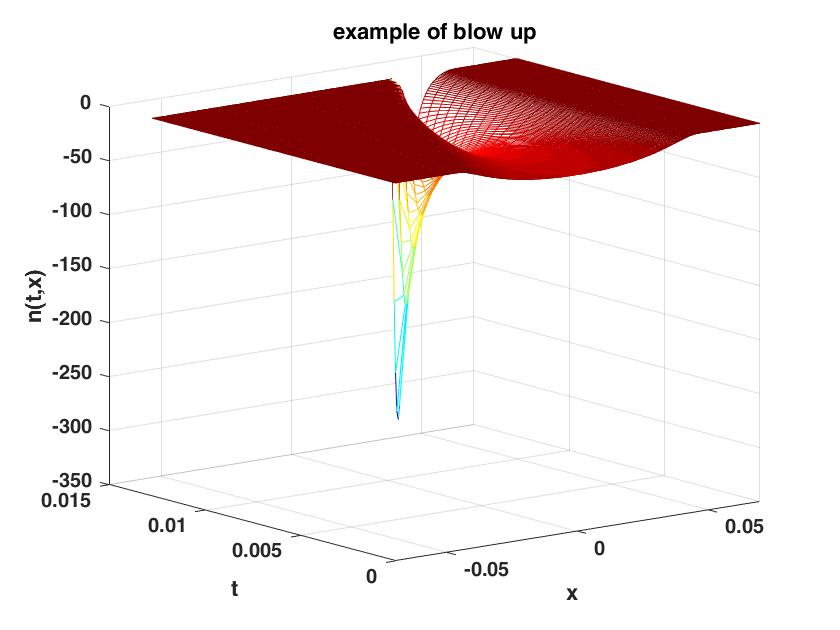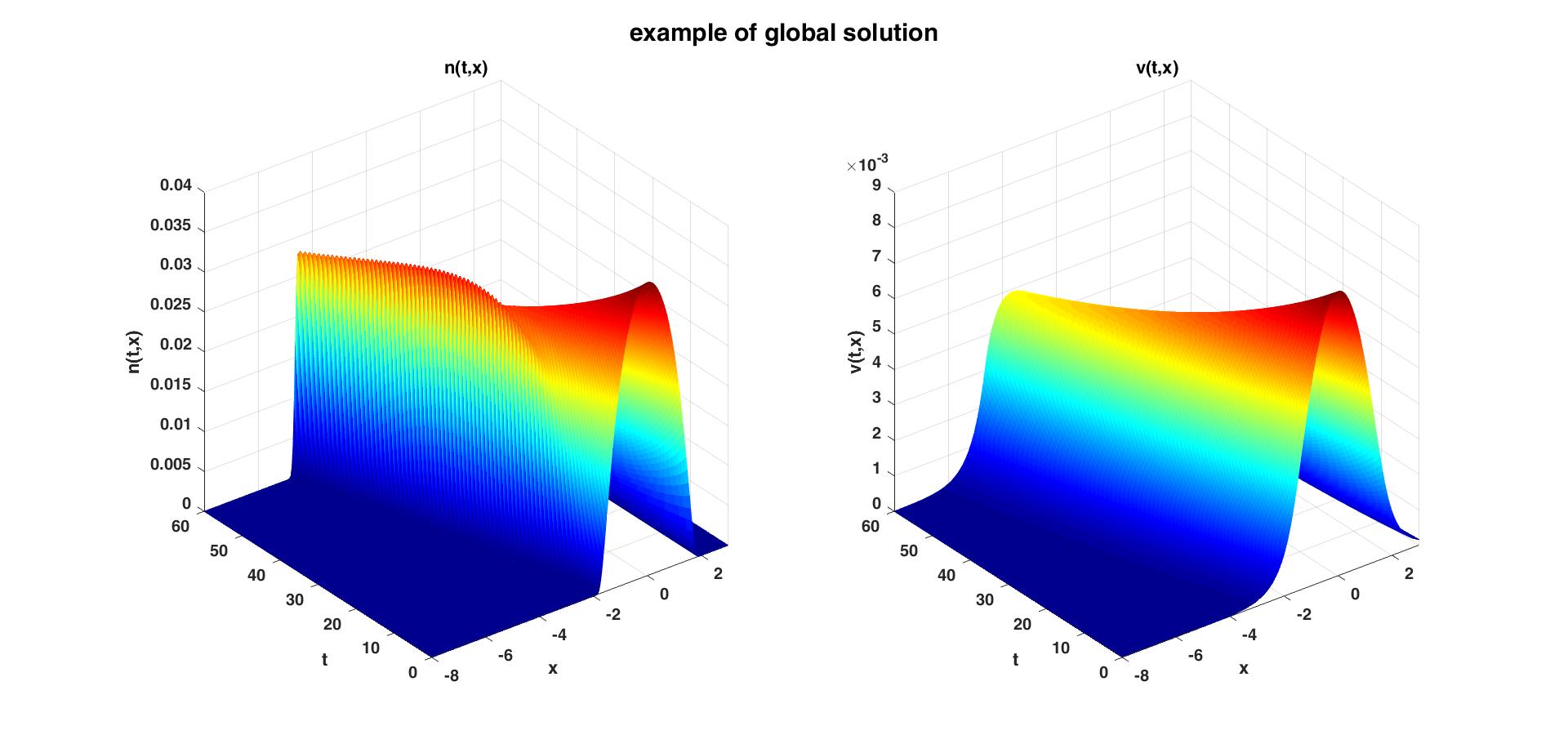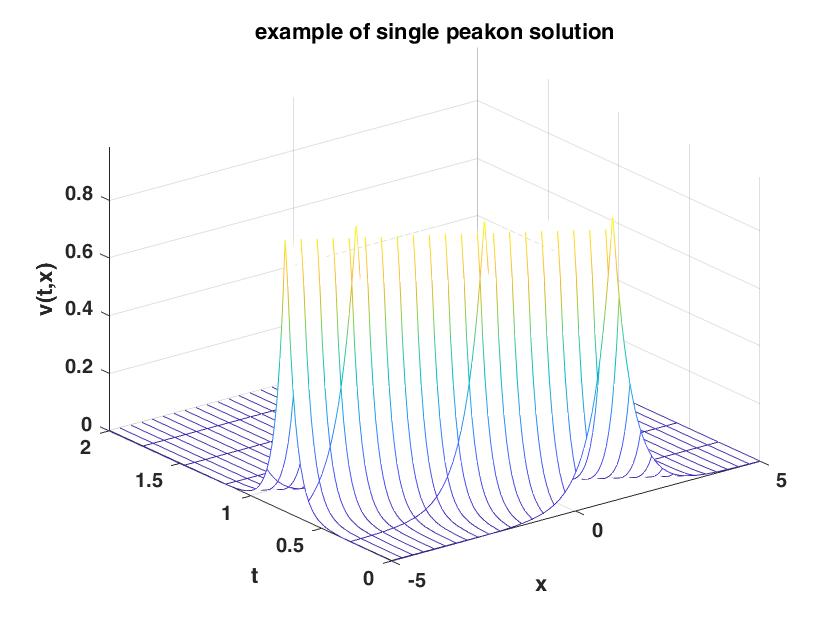The local well-posedness, blow-up and global solution of a new integrable system in Besov spaces
Abstract
In this paper, we first establish the local well-posednesss for the Cauchy problem of a -peakon system in the sense of Hadamard in both critical Besov spaces and supercritical Besov spaces. Second, we gain a blow-up criterion. According to blow-up criterion wemreach a precise blow-up criterion. Under a sign condition, we reach the existence of global solution. Finally, based on the first-order difference method, we give a simulation example of the blow-up of the equation and the properties of the global solution.
1 Introduction
Korteweg-de Vries (KdV) equation which was introduced to describe the behavior of long waves on shallow water in the most famous model in soliton theory, because it is integrable and includes the phenomena of soliton interaction. But the KdV equation cannot model the occurrence of breaking waves. In 1993, Camassa and Holm obtain a nonlinear partial differential equation [2]
which is named Camassa-Holm (CH) equation.
A particular feature of the CH equation is that when it admits peaked soliton solutions which are also called peakons. It can be regarded as a shallow water wave equation.[2, 8, 18]. Its complete integrability was discussed in [2, 4, 9]. The CH equation also has a Hamilton structure[3, 12], and admits exact orbitally stable peaked solitons of the form with . The local well-posedness of the Cauchy problem of CH equation in Besov spaces and Sobolev spaces was proved in [5, 6, 10, 22].
Since constructing peakon equation are interested in the fields of Physics and Mathematics. Based on an asymptotic integrability approach, Degasperis and Procesi discovered a new equation which has peakon solutions[20, 11]. Similarly, the Cauchy problem of the DP equation is locally well-posed in certain Sobolev and Besov spaces[24, 16, 25]. And Geng and Xue constructed a two component peakon with cubic nonlinearity[13], three components generalization of CH equation[14] and super CH equation with -peakon[15].
Geng and Xue constructed from the compatibility of a matrix spectral problem, a new nonlinear evolution with -peakon is derived[23]
| (1.1) |
It is shown in that system (1.1) admits exact solutions with -peakon, which takes the form
where and evolve according to a dynamical system.
After some transformations, (1.1) can be changed into a transport-like equation
| (1.2) |
with , .
In this paper, firstly, applying Littlewood-Paley theory and transport theory, for the initial data in certain Besov spaces of high regularity or of critical regularity, complete the locally well-posedness in Besov space with or or , we prove the local solution to equation (1.1) exists uniquely and depends continuously on the initial data. And we will talk about the blow-up criterion and the blow up condition of initial data. In the last part of the paper,according to the structure of equation, we can find a sign-preserved property, and by the virtue of the high-preserved we see that the -norm of v is non-increasing, then we can finally give the condition of existence of the global solution.
2 Preliminaries
In this section, we will present some propositions about the Littlewood-Paley decomposition and the non homogeneous Besov spaces with their properties.
Proposition 2.1 (Littlewood-Paley decomposition).
Then for all , we can define the nonhomogeneous dyadic blocks as follows. Let
Hence,
where the right-hand side is called the nonhomogeneous Littlewood-Paley decomposition of .
According to Young’s inequality, we get
The low frequency cut-off operator is defined by
and the Littlewood-Paley decomposition is quasi-orthogonal in in the following sense:
Definition 2.2 (Nonhomogeneous Besov space).
In the following lemma, we list some important properties of Besov spaces.
Lemma 2.3.
[1, 17]
Let . We have
(1) is a Banach space, and is continuously embedded in .
(2) If , then . If , is dense in .
(3) If and , then .
If , the embedding is locally compact.
(4) , is an algebra. Moreover, is an algebra.
(5) Complex interpolation:
| (2.1) |
(6) Logarithm interppolation: , and , there exists a constant such that
| (2.2) |
(7) Fatou property: if is a bounded sequence in , then an element and a subsequence exists such that
(8) Let and be a - multiplier, (i.e. is a smooth function and satisfies that , , such that . Then the operator is continuous from to .
Proposition 2.4.
, we have is a -multiplier, and is a -multiplier.
Next, we introduce the paradifferential calculus of Besov space and the main continuity properties of the paraproduct and the remainder.
Definition 2.5.
[1] The nonhomogeneous paraproduct of v by u is defined by
The nonhomogeneous remainder of u and v is defined by
Lemma 2.6.
We then have the following product laws:
Lemma 2.7.
Proposition 2.8.
[1] Let
| (2.3) |
defines a continuous bilinear functional on . Denoted by the set of functions in such that . If is in , then we have
We now state the definition of Osgood modulus of continuity and Osgood lemma.
Definition 2.9.
[1] Let . Nondecreasing nonzero continuous function is defined on and , then is called a modulus of continuity. And if is called an Osgood modulus of continuity if
The Osgood lemma are useful to prove the uniqueness of some ordinary differential equations and one can utilize a procedure to construct a large families of Osgood functions.
Lemma 2.10 (Osgood lemma).
[1] Let be a measurable function mapping to , is a locally integrable function from to , and is a nondecreasing function mapping to . Assume that, for some nonnegative real number , the function satisfies
If is positive
If and is an Osgood modulus of continuity, then .
Next, we state some useful result in the transport equation theory, which are crucial to the proofs of our main thorems later. Let us consider the linear transport equation:
| (2.4) |
Lemma 2.11 (A priori estimates in Besov spaces).
[1] Let . Assume that
There exists a constant such that for all solutions of (2.4) in -dimensional space with initial data , and , we have for a.e. ,
or
with
If for all
Lemma 2.12.
Lemma 2.13.
Lemma 2.14.
[19] Let . Denote . Let . Assume that is the solution to
with and for some
If in as tends to , then in as tends to .
3 Local well-posedness
In this section, we will establish the local well-posedness for the Cauchy problem (1.1) or (1.2) in Besov spaces. We want to solve the Cauchy problem (1.2) directly by general Picard scheme and transport equation theory, but we will fail to do that due to the loss of regularity of the transport term. By Prop 2.4, we can overcome the difficulty by solving the Cauchy problem (1.1).
Firstly, we give a definition as follows
Definition 3.1.
Let and . Denote
Theorem 3.2.
Let and satisfies the condition
| (3.1) |
Let with be in . Then (1.1) has a unique maximal solution in and depends continuously on the initial data .
Moreover, there exists a positive constant , depending only on
Proof.
Now we prove Theorem 3.2 as the following steps.
Step 1: Constrcuting Approxiamte Solitions and Uniform Bounds.
Denoting , we define a sequence of smooth functions by solving the following linear transport equation:
By induction, we assume that . Since is an -multiplier and
also noticing that is an algebra when satisfies the condition (3.1) and the embedding , we obtain
At the same time , and denote that
Applying Thm2.11, we have
| (3.2) |
We may assume and fix a
| (3.3) |
Suppose that , satisfies
| (3.4) |
Note that
Plugging (3.4) into (3.2) yields
| (3.5) |
Therefore, is uniformly bounded in . According to the system and Lemma2.11 and Lemma2.12, we can deduce that is uniformly bounded in .
Step 2: Convergence and Regularity.
We will claim that is a Cauchy sequence in , if or ; or of if .
Indeed, for all , taking the difference between the system and , and denote , we have
| (3.6) |
Case1: or
First, estimate the left-hand side of system (3.6) in . In fact, by Lemma2.6 and Lemma2.4, we can see
Also we can obtain
Now, recalling (3.4) and the uniform bound estimates of , and making use of Lemma2.11 or Lemma2.12 to the system (3.6), we have
where is a constant, then by induction as tends to
which means , and by Fatou’s property, we obtain that .
Now for any test function in the system , applying Prop2.8, and taking the limits, it is not hard to check that is a solution to the system (1.1).
Case2: and
Since the critical index , we can only apply Lemma2.11 in the stage space . And noticing that , and applying Lemma2.6 to the system (3.6)
Also we can obtain the initial data of system (3.6) satisfies
Since and , we obtain the estimate of the flow
According to the logarithm interpolation of Lemma2.3, and the uniform bound of , we obtain
denote that , then we have
Note that , thus it is obvious that is an Osgood modulus of continuity. Applying Lesbesgue-Fatou’s lemma in real analysis, we conclude that, for
Hence according to the Osgood lemma, we have
which implies that is a Cauchy sequence in the space and converges to the limit function .Along the same line of Case1, similarly we deduce that is a solution to (1.1) and .
Step 3: Uniqueness.
Suppose are two solutions of (1.1) with initial data and respectively. Denoting , we have
| (3.7) |
If or , along the same computation in step 2, , we have inequality
By Gronwall’s inequality
| (3.8) |
If , similar to step 2, we have inequality
denote and , obviously, since
then we have
Since is an Osgood modulus of continuity on , then by Osgood lemma, we get inequality
then by the definition of , we have
| (3.9) | ||||
Then the uniqueness of solution to the system (1.1) in the space follows from (3.8) and (3.9).
Step 4: Continuous Dependence.
Now according to Lemma2.14, denote . suppose is the solution to (1.1) with initial data , then we have a sequence of systems
with .
Next we claim that if in when tends to , then in with satisfying .
(1) r¡. Decompose into , and satisfy
Denote , and letting , according to the proof of the existence, we get that
Hence, is uniformly bounded in and
also it is obvious that
similar to the proof of the uniqueness, since in , then we have in in . Then by Lemma2.14
in as
Therefore, we have , large enough, when , , then
by Gronwall’s inequality,
Hence we gain the continuity of the system (1.1) in with respect to the initial data in .
(2) . Similar to Step2, we have . Then , we have
and
by Lemma2.3, we can conclude that as for . Thus we gain the continuity of the system (1.1) in with respect to the initial data in .
∎
4 Blow-up criterion
We can use the method introduced by Zhang and Yin[blowupcriterion] to obtain a blow-up criterion as follows.
Theorem 4.1.
Proof.
For simplicity, consider the case . For all satisfies , according to the product laws, since and , we have
| (4.1) |
(1) .
(3)
If , we can repeat the above process. Indeed, since
we similar have
By induction, we can choose such that , and , gives that
Therefore we can conclude that
Return to and suppose , we have:
Case1: s¡1 By (1), we have .
Case2: s=1 By (1), we have and by (2) we get that .
Case3: s¿1 By (1), we have and by (2) we get that , lastly by the induction in (3), we can deduce that .
Therefore . Then by what we proved in Thm3.2, small enough such that for some suitable , , then follow then same line of Step1 in the proof of Thm3.2, we can extend the solution on to on and by the uniqueness for any .
∎
5 Blow-up
As we have the blow-up criterion, consider the following initial value problem
| (5.1) |
then the system (1.1) in Lagrangian coordinates can be written as
| (5.2) |
Theorem 5.1.
More precisely, will blow up at time .
Proof.
Consider the system (5.2) for all , then it is obvious that for all
and
denote , then according to (5.2), we have
Consider the ordinary differential equation
then we have
It is obvious that is an increasing function, and by (5.3)
then we can easily get that and .
Therefore will blow up at time . ∎
6 Existence of global solution
Similarly, we consider the initial value problem (5.1), applying classical results in the theory of ODEs, one can obtain the following results of .
Lemma 6.1.
We then have the following sign-preserved result.
Lemma 6.2.
Let and . Assume is the maximal existence time of the solution to (1.1), then
Proof.
Noticing and, we get . Since is a diffeomorphism on , we completes the proof. ∎
Lemma 6.3.
Let and . Assume is the maximal existence time of the solution to (1.1) with initial data . Then
Proof.
Since we have
and
On the other hand, for almost , we have
∎
Lemma 6.4.
Let and . Define an equivalent norm of -norm:
Then the -norm of in is non-increasing, namely, if
Proof.
Since , according to Lemma6.3, it follows that and . Hence for any , we have
Integrating the above inequality on and we have
∎
Theorem 6.5.
Let with and , the system of (1.1) has a unique global solution, i.e. .
7 Simulation
According to our blow up condition, we can construct an exact example of the system (1.1).
Let and denote
taking , it is obviously that . Since , by Young’s inequality we can get the rough estimate of and
then we can denote and .
It is obvious that
then we have will blow up within .
The solution of system (1.1) with the initial data can be roughly expressed as Figure 1:

It is consistent with the approximate numerical calculation of blow up condition we have given.
And for , it is easy to check that for all and , the solution of system (1.1) with the initial data can be roughly expressed as Figure 2:

It is consistent with the existence of the global solution. And the above figure of the solution is similar to the exact single peakon of the form[23]

References
- [1] H. Bahouri, J.-Y. Chemin, and R. Danchin. Fourier analysis and nonlinear partial differential equations, volume 343 of Grundlehren der mathematischen Wissenschaften [Fundamental Principles of Mathematical Sciences]. Springer, Heidelberg, 2011.
- [2] R. Camassa and D. D. Holm. An integrable shallow water equation with peaked solitons. Phys. Rev. Lett., 71(11):1661–1664, 1993.
- [3] A. Constantin. The Hamiltonian structure of the Camassa-Holm equation. Exposition. Math., 15(1):53–85, 1997.
- [4] A. Constantin. On the scattering problem for the Camassa-Holm equation. R. Soc. Lond. Proc. Ser. A Math. Phys. Eng. Sci., 457(2008):953–970, 2001.
- [5] A. Constantin and J. Escher. Global existence and blow-up for a shallow water equation. Ann. Scuola Norm. Sup. Pisa Cl. Sci. (4), 26(2):303–328, 1998.
- [6] A. Constantin and J. Escher. Well-posedness, global existence, and blowup phenomena for a periodic quasi-linear hyperbolic equation. Comm. Pure Appl. Math., 51(5):475–504, 1998.
- [7] A. Constantin and R. I. Ivanov. On an integrable two-component Camassa-Holm shallow water system. Phys. Lett. A, 372(48):7129–7132, 2008.
- [8] A. Constantin and D. Lannes. The hydrodynamical relevance of the Camassa-Holm and Degasperis-Procesi equations. Arch. Ration. Mech. Anal., 192(1):165–186, 2009.
- [9] A. Constantin and H. P. McKean. A shallow water equation on the circle. Comm. Pure Appl. Math., 52(8):949–982, 1999.
- [10] R. Danchin. A few remarks on the Camassa-Holm equation. Differential Integral Equations, 14(8):953–988, 2001.
- [11] A. Degasperis, D. D. Holm, and A. N. W. Hone. A new integrable equation with peakon solutions. (2), 2002.
- [12] B. Fuchssteiner and A. S. Fokas. Symplectic structures, their Bäcklund transformations and hereditary symmetries. Phys. D, 4(1):47–66, 1981/82.
- [13] X. Geng and B. Xue. An extension of integrable peakon equations with cubic nonlinearity. Nonlinearity, 22(8):1847–1856, 2009.
- [14] X. Geng and B. Xue. A three-component generalization of Camassa-Holm equation with -peakon solutions. Adv. Math., 226(1):827–839, 2011.
- [15] X. Geng, B. Xue, and L. Wu. A super Camassa-Holm equation with -peakon solutions. Stud. Appl. Math., 130(1):1–16, 2013.
- [16] G. Gui and Y. Liu. On the Cauchy problem for the Degasperis-Procesi equation. Quart. Appl. Math., 69(3):445–464, 2011.
- [17] H. He and Z. Yin. On a generalized Camassa-Holm equation with the flow generated by velocity and its gradient. Appl. Anal., 96(4):679–701, 2017.
- [18] D. Ionescu-Kruse. Variational derivation of two-component Camassa-Holm shallow water system. Appl. Anal., 92(6):1241–1253, 2013.
- [19] J. Li and Z. Yin. Well-posedness and global existence for a generalized Degasperis-Procesi equation. Nonlinear Anal. Real World Appl., 28:72–90, 2016.
- [20] H. Lundmark and J. Szmigielski. Multi-peakon solutions of the degasperis-procesi equation. Inverse Problems, 19(6), 2005.
- [21] W. Luo and Z. Yin. Local well-posedness and blow-up criteria for a two-component Novikov system in the critical Besov space. Nonlinear Anal., 122:1–22, 2015.
- [22] G. Rodríguez-Blanco. On the Cauchy problem for the Camassa-Holm equation. Nonlinear Anal., 46(3):309–327, 2001.
- [23] B. Xue, H. Du, and X. Geng. New integrable peakon equation and its dynamic system. Appl. Math. Lett., 146:Paper No. 108795, 7, 2023.
- [24] K. Yan and Z. Yin. On the Cauchy problem for a two-component Degasperis-Procesi system. J. Differential Equations, 252(3):2131–2159, 2012.
- [25] Z. Yin. Global existence for a new periodic integrable equation. J. Math. Anal. Appl., 283(1):129–139, 2003.